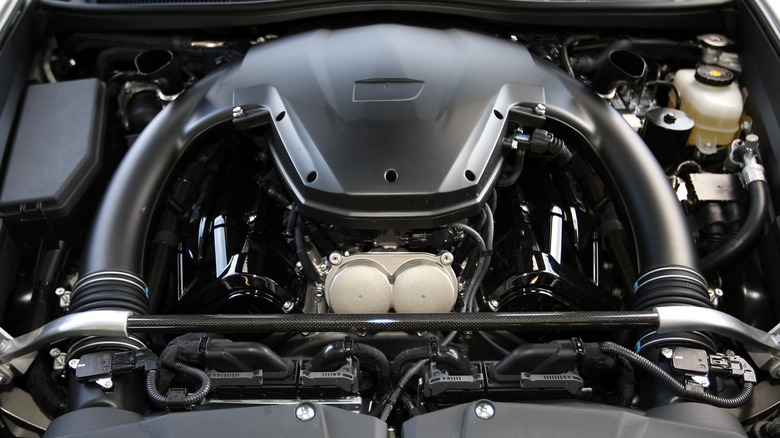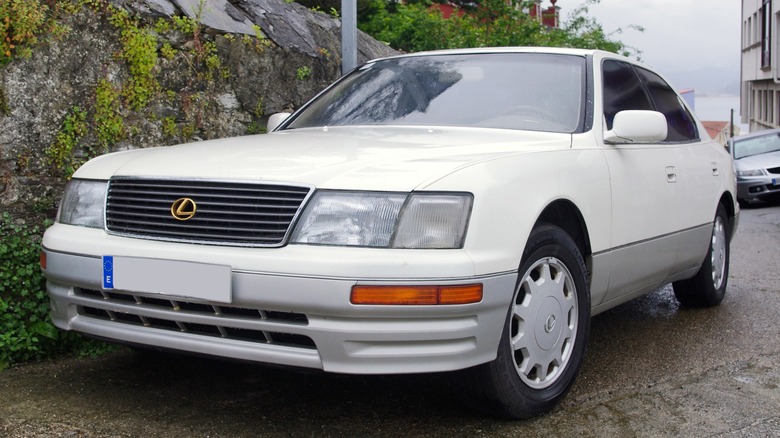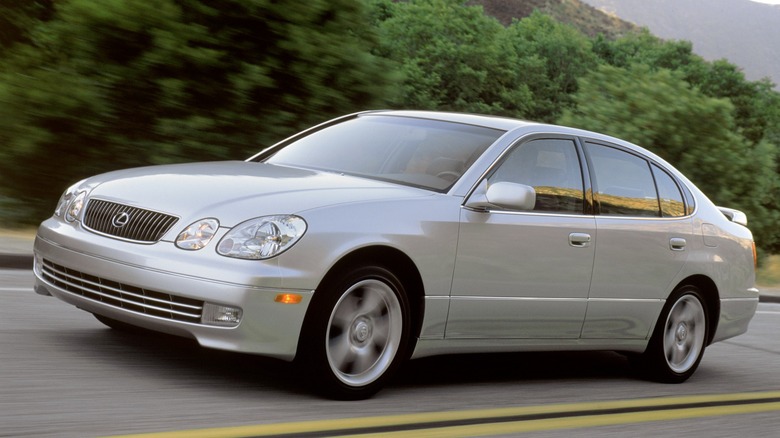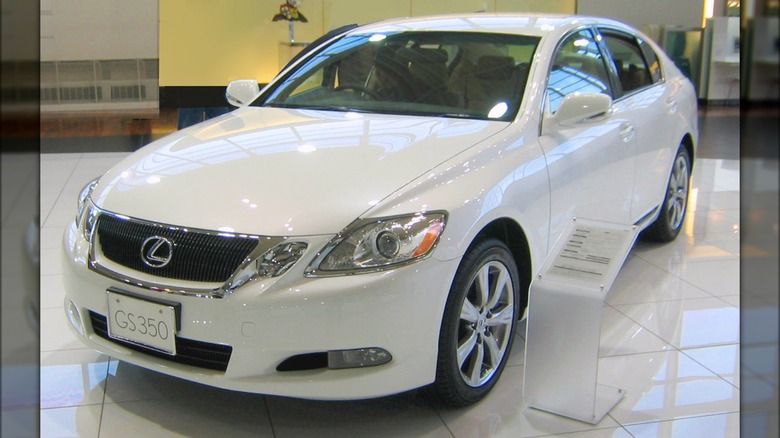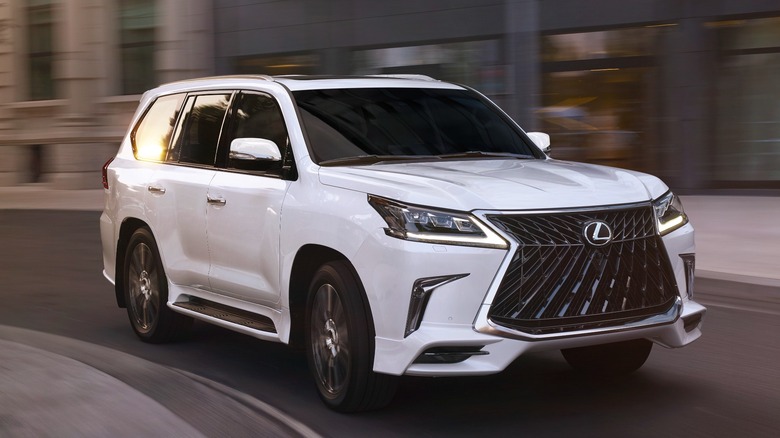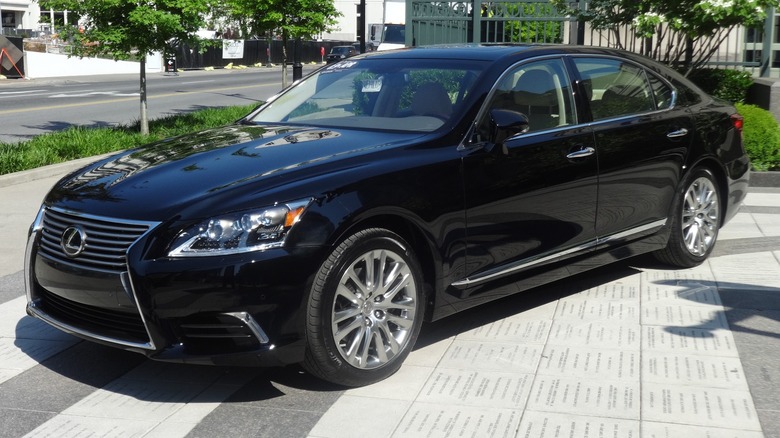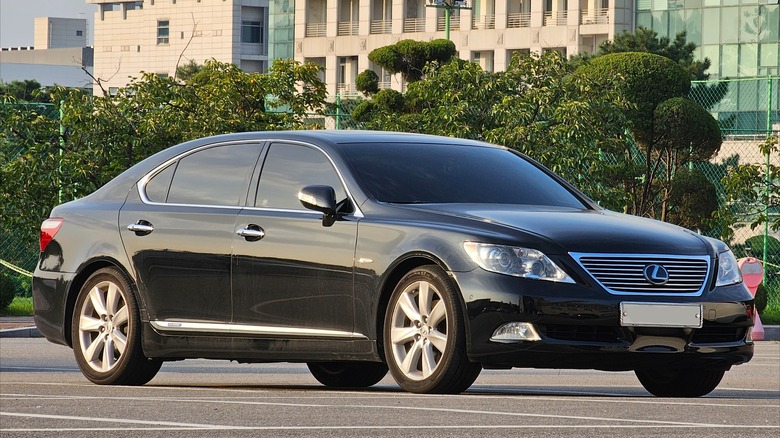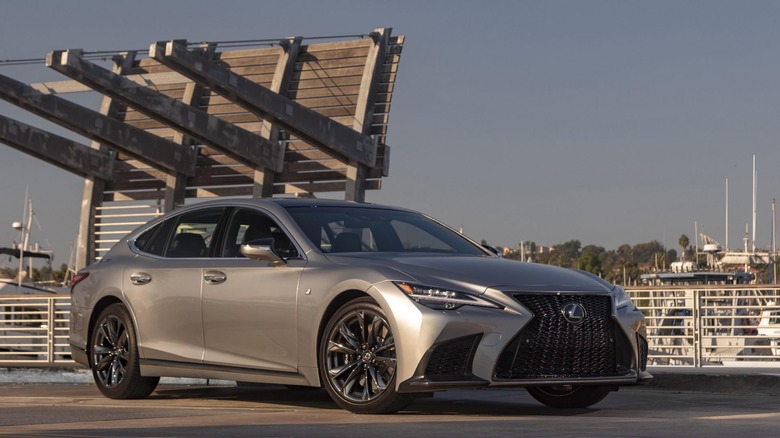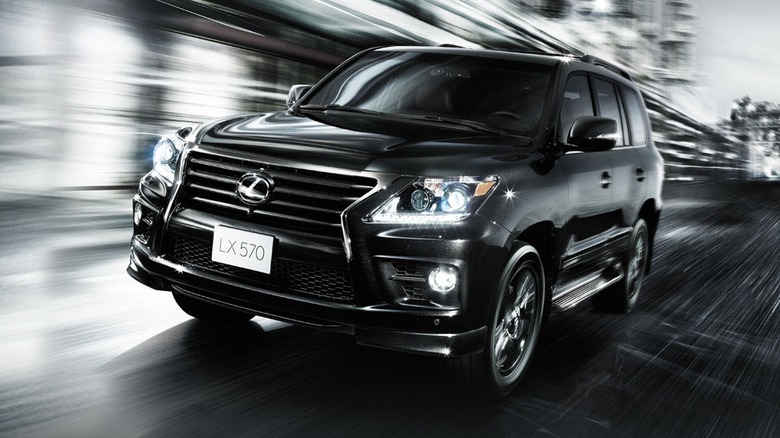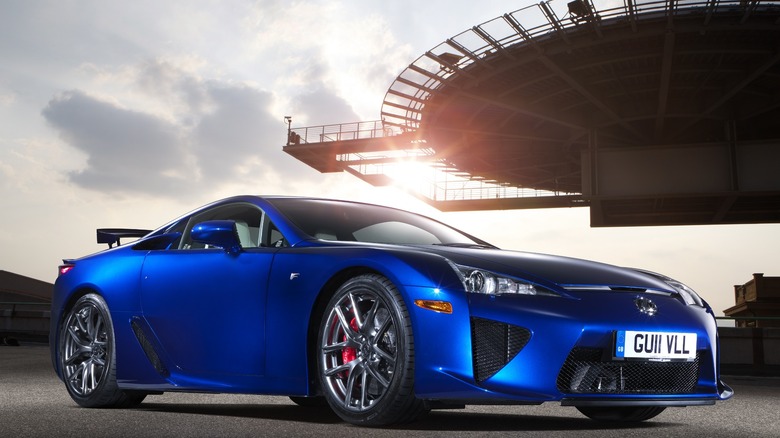10 Of The Most Powerful Engines Ever Put In A Lexus
When you think of power, you probably don't think of Lexus. Born from a top-secret early-1980s meeting, the brand made a splash when it launched the LS 400 in 1990. The LS 400 offered luxury and comfort on par with contemporary BMW and Mercedes offerings but at less than half the price of a Mercedes S-Class. Sure, it only had 250 horsepower, but it made great use of what it had, with its smooth power delivery winning journalists over regardless.
With that sort of pedigree, you'd be mistaken for thinking that Lexus' offerings have always focused on the gentler, classier side of the automotive spectrum. And while you wouldn't be entirely wrong, cars like the 2024 Lexus LC 500 show that there's more to the brand than luxury four-door cars for the middle-management set. The LC 500 is fun to drive and, most importantly, packs a decent amount of power under the hood, with 471 horses at the command of your right foot.
So, yes: there's more to Lexus than luxury, and some of the engines Toyota has used for its sub-brand paint that picture well. From the humble 300-horsepower powerplants at the turn of the millennium to the wonderful 550-horsepower V10 powering the Lexus LFA, here's are the most powerful engines to ever grace a Lexus' engine bay.
4.0-liter 1UZ-FE - 300 horsepower
Covering Lexus' higher-horsepower engines begins with the one that started it all: the 4.0-liter 1UZ-FE V8. The all-aluminum 1UZ-FE was the engine that powered Lexus' market-disrupting LS 400, earning plaudits for the smooth way it delivered its 250 horsepower and 260 lb-ft of torque. Sure, it wasn't as powerful as its pricier rivals, but power isn't everything.
Even though everyone seemed to love the 1UZ, Toyota didn't rest on its laurels and continued to improve the engine over the LS 400's two generations. The second-generation 1995 LS 400 saw numbers increase ever-so-slightly to 260 horsepower and 270 lb-ft of torque alongside a larger and cushier interior. Combine that with a 200-pound weight loss, and the 1995 LS 400 could take its owner to 60 mph in 7.4 seconds: nothing special, but likely plenty fast enough for its target audience.
1998 saw Toyota eke even more power from the 4.0-liter engine, to the tune of 290 horsepower and 300 lb-ft of torque in that year's LS 400. The LS 400 wasn't alone: the U.S.-market version of the new-for-1998 second-generation GS 400 also sported the updated 1UZ-FE. Befitting its smaller size and somewhat sportier — by Lexus standards — image, Lexus gave the GS a bit more power. Owners of the new GS had 300 horsepower and 310 lb-ft on tap, allowing them to outrun a contemporary Porsche Boxster — to 60 mph, at least.
[Image by Spanish Coches via Wikimedia Commons | Cropped and scaled | CC BY 2.0]
4.3-liter 3UZ-FE - 310 horsepower
The 4.3-liter 3UZ-FE V8 debuted in Lexus' new third-generation LS 430 and the mid-generation GS 430, both of which the company introduced in 2000 for the 2001 model year. Both cars previously had Toyota's 4.0-liter 1UZ-FE engine under the hood, and the 3UZ was more of the same — just with a larger displacement.
Toyota kept the 1UZ's 3.25-inch stroke but bored the engine out to 3.58 inches from 3.44 inches. The result was a minor bump in displacement of 0.3 liters and a similarly small boost to power output. Compared to the 290 horsepower and 300 lb-ft of torque from the final iteration of the LS 400's 1UZ V8, the new 3UZ-FE made 300 horsepower in the GS 430 and 290 horsepower in the LS 430. Both versions of the new 4.3-liter made more torque, too, with the GS 430 making 325 lb-ft and the LS 430 having 320 lb-ft — so the extra displacement did bring some performance improvements in the LS, even if horsepower output was identical.
The updated engine made peak horsepower and torque lower in the rev range, too, so owners didn't have to rev the engine as high to enjoy what it had to offer. Despite the minor power upgrade, reviewers loved the new LS 430 and GS 430, and both remain highly regarded to this day.
3.5-liter 2GR-FSE - 311 horsepower
Toyota has generally favored eight-cylinder engines for its Lexus cars, but that doesn't mean there haven't been a couple of reasonably perky six-cylinder Toyota engines over the marque's nearly 40-year history. One such engine is the 3.5-liter Toyota 2GR-FSE V6, which the company dropped into the Lexus GS 350's engine bay in the mid-2000s.
Given that Lexus is a Japanese brand, it probably won't surprise that the 2GR-FSE's debut in the 2005 Lexus GS 350 was a Japan-only deal. The V6 was one of two engines Toyota offered in the 2005 GS, with the other being the 4.3-liter 3UZ-FE in the GS 430 we discussed earlier. Interestingly, the smaller engine made a hair more power, with 311 horsepower and 277 lb-ft of torque in both rear- and all-wheel drive setups for the Japanese GS 350.
U.S. Lexus GS buyers had to endure the old 245-horsepower 3.0-liter V6 for an extra couple of years, but their wait thankfully wasn't too long. Lexus introduced the GS 350 to the American market in 2007, although it had slightly less power than its Japanese counterpart. The V6 made 303 horsepower and 274 lb-ft of torque in the U.S., which, while lower on paper, likely didn't make much difference in the real world. 60 mph still arrived in a commendable 5.3 seconds, with the engine delivering power via all-wheel drive and a six-speed sequential transmission.
[Image by Altair78 via Wikimedia Commons | Cropped and scaled | CC BY-SA 4.0]
5.7-liter 3UR-FE - 383 horsepower
Big vehicles demand big engines, and few in Lexus' lineup have been as large as the LX SUV. The LX range debuted with the ultra-reliable, Land Cruiser-derived LX 470 in 1996 and has been the company's premier luxury full-size SUV offering since the third-generation LX 570 debuted in 2007. The LX 570 brought a range of improvements over the previous generations, including more luxury, a new chassis, and a redesigned suspension — plus, most importantly, a big honking V8 under the hood.
The LX 570's 3UR-FE's 5.7 liters dwarfed the old 4.7-liter unit in the LX 470 in size and power. The old unit made only 230 horsepower and 320 lb-ft of torque and, while that didn't affect reviewers' opinions of it — most of which were positive, not least thanks to its luxurious ride — it probably wasn't a surprise when Lexus announced that the LX 570's 3UR-FE made 383 horsepower and 403 lb-ft of torque.
Unlike its predecessors, the LX 570 was long-lived, staying at the top of the Japanese manufacturer's SUV lineup from its 2007 debut to 2021 without much in the way of mechanical changes. Lexus introduced an eight-speed auto in a 2016 update, but the SUV remained broadly the same underneath, with the 5.7-liter V8 making the same 383 horsepower throughout its life. There is one notable exception, however.
4.6-liter 1UR-FSE - 386 horsepower
Toyota was on a tear in the mid-2000s, consistently updating the Lexus lineup with larger, more powerful engines. The flagship LS four-door was no exception, with the brand introducing the 2007 model year LS 460 at the 2006 Detroit Auto Show with several updates, including an all-new engine.
Unlike the transition from the LS 400 to the LS 430, the 4.6-liter 1UR-FSE V8 in the new LS 460 had little to do with the previous generation's engine. The UR engines were all-new replacements for Toyota's old UZ engines that sported upgrades such as variable valve timing, timing chains, and dual fuel injection. These updates likely led to the significant power increase, with the new engine making 380 horsepower and 370 lb-ft in the 2007 LS 460 and 460L. Interestingly, all-wheel-drive versions of the LS 460 had less power, with 357 horsepower and 344 lb-ft of torque on tap.
Lexus also introduced a new eight-speed automatic transmission, although reviewers weren't particularly thrilled by the firm's choice of gear ratios, finding that the gearing impeded the car's acceleration times. The LS 460 nailed the luxury and comfort aspects of the equation, though, and was well-liked regardless of its lack of sporting prowess. Toyota managed to squeeze more power out of the 4.6-liter V8 for the 2013 LS 460, bringing it up to 386 and 360 horsepower for the rear- and all-wheel-drive versions, respectively.
[Image by Michael Rivera via Wikimedia Commons | Cropped and scaled | CC BY-SA 4.0]
5.0-liter 2UR-FSE - 389 horsepower
Unlike many of its fellow car manufacturers, Toyota has been famously reticent to go all-in on the EV revolution. As of 2024, the company only offers one fully electric car for sale, and it's not even a particularly exciting one — at least, compared to cars like the great-looking (and driving) 2025 Hyundai Ioniq N. Hybrids are a whole other matter, though, with a decent range of cars across its brands coming with electric assistance. One such car was the Lexus LS 600h, which debuted in 2007.
The LS 600h and long-wheelbase LS 600hL sported Toyota's 5.0-liter 2UR-FSE V8 under the hood paired with a high-output electric motor and all-wheel-drive. Toyota based the 2UR-FSE V8 on the 1UR V8 in the non-hybrid LS 460, with a hair more power — 389 horsepower — than its all-gasoline version. Toyota complemented this with a 221-horsepower electric motor, resulting in a total power output of 438 horsepower.
Either way, the combination was powerful enough to get the luxury sedan to 62 mph in just 5.5 seconds, with the long-wheelbase version slightly slower at 6.3 seconds. Sure, nothing that'll impress the drag racers amongst you, but mighty impressive considering the 600h's nearly 5,500-pound curb weight. The LS 600 and 600h stayed in the Lexus lineup for a decade before the company introduced the V6 hybrid LS 500h in 2017.
[Image by Damian B Oh via Wikimedia Commons | Cropped and scaled | CC BY-SA 4.0]
3.5-liter V35A-FTS - 416 horsepower
Most of the big-power engines Toyota's crammed into Lexus engine bays over the years have been V8s, but the V35A-FTS shows that the company can make good power even with two fewer cylinders. Debuting in the 2017 Lexus LS 500, the V35A-FTS follows in the footsteps of powerful V6s like Nissan's classic VR38DETT, opting for twin turbos to compensate for the reduced displacement and cylinder count.
While you won't ever mistake the V35A for a 600-horsepower, Nissan-beating monster, Toyota's 3.5-liter V6 still makes decent power, with 415 horsepower and 442 lb-ft of torque on offer. You're not going to light up the drag strip with this, but that's good enough for a luxury sedan like the LS (yes, that's what it stands for). Besides, as Chris Davies found out when he got behind the wheel of a 2024 LS 500, it's not a car meant for sporty driving: in that situation, 400-odd horsepower is more than decent.
The 3.5-liter V6 also appears in two current (as of 2024) Lexus SUVs, namely the LX 600 and GX 550. Lexus opted to retune the engine for both vehicles, prioritizing torque above raw horsepower. The LX 600 makes 409 horsepower, while the GX 550 — which earned an Editor's Choice award — makes 349 horsepower. Torque is up in both SUVs, though, with both implementations of the V6 making 479 lb-ft of torque at 2,000 rpm.
5.7-liter supercharged 3UR-FE - 450 horsepower
Honestly, the LX 570's 383 horsepower and 403 lb-ft wasn't all that much, especially not considering its nearly 6,000-pound curb weight. But while most LX 570 owners had to live with that — at least, without mods — the well-heeled SUV fan in the Middle East could get their hands on something special in 2015: the LX Supercharger.
As the name suggested, this limited-to-200 luxury SUV — which Lexus introduced to celebrate its 25th year — boasted a supercharged version of the 5.7-liter 3UR-FE. The boost made for a significant power uptick, with the 5.7-liter V8 now producing 450 horsepower and 521 lb-ft of torque. That's still not quite on par with some of the most powerful SUVs, but certainly a good upgrade over the original. The result? An alleged zero to 62 mph time of less than seven seconds, a marked improvement over the standard LX 570's 7.8 seconds.
Whether acceleration times matter all that much in a full-size SUV is a whole other matter, but that didn't stop buyers in the Middle East from snapping the limited-edition model up: The company sold all 40 of its first batch in the first few months of 2014 — even at an eye-watering price of around $160,000 in today's money. Buyers certainly got their money's worth, though: beyond the beefed-up engine, the LX Supercharger also sported extras such as a red leather interior, a Mark Levinson sound system, and power tailgate as standard.
5.0-liter 2UR-GSE - 471 horsepower
The 2UR-FSE V8 in the Lexus LS 600h was a decent enough gasoline engine, but it relied on electric power to bring the total combined numbers up into the 400-plus horsepower club — a small one, as far as Lexus' cars go. But the pure gasoline equivalent of the engine, the 5.0-liter 2UR-GSE, was a different beast, hitting a peak of 471 horsepower in its most powerful form. But this particular V8 had a slightly humbler start to its life, as far as raw power output goes.
Humble doesn't mean low-powered, though: the 2UR-GSE was never a sub-400-horsepower motor, not even when it debuted in the 2007 Lexus IS-F. This earliest incarnation of the engine still made a healthy 417 horsepower and 372 lb-ft of torque, likely thanks to its high 11.8:1 compression ratio. The engine had more to give, as later Lexus efforts would show, but it stayed at its 417-horsepower output throughout the IS-F's run.
A year after Lexus discontinued the IS-F in 2014, the company introduced the performance-minded two- and four-door RC F and GS F, before coming to the two-door LC 500 in 2017. Both featured the 2UR-GSE in its full 471-horsepower and 391-lb-ft glory, good enough to take the four-door GSF to 62 mph in 4.6 seconds. Lexus continues to sell the 2UR-equipped RC F in 2024, although the full 471 horsepower is only available in U.S. models. European models from 2018 onward only have 457 horsepower due to emissions regulations.
4.8-liter 1LR-GUE - 552 horsepower
The 4.8-liter 1LR-GUE engine powers one of Lexus' best cars and is the most powerful engine Toyota has ever built. This Toyota-Yamaha collaboration was an F1-inspired engine built specifically for the legendary Lexus LFA, which Toyota first announced in 2009.
The LFA had a protracted development process, but reviewers raved about its race-car-like handling and responsiveness, which were already good enough to set it apart from many of its supposed rivals. But the Toyota-Yamaha powerplant — and its legendary exhaust note — was, for most journalists of the time, the star of the show. The 1LR-GUE was a high-revving beast, producing 552 horsepower at 8,700 rpm, while its 354 lb-ft peak torque figure came at 5,000 rpm. Admittedly, it wasn't the torquiest engine ever, but the LFA's carbon fiber-heavy construction meant that it didn't need that much torque in the first place, a fact that the car duly proved with a zero-to-62-mph time of 3.7 seconds.
The bespoke 1LR-GUE delivered power to the rear wheels through another Toyota collaboration, this time with gearbox manufacturer Aisin. The two companies opted for a traditional six-speed transmission with seven shift speed options ranging from 0.2 to one second. It wasn't cutting-edge — dual-clutch transmissions were becoming the norm by 2011 — but it got the job done. Toyota built just 500 LFAs between 2010 and 2012, each costing around $350,000. You'll be hard-pressed to find one for anything close to that today: most sell for $800,000 or more, befitting their rarity.
